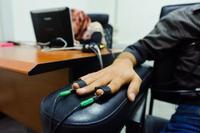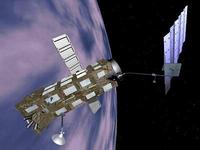-
Advancing algae’s viability as a biofuel
Lab success does not always translate to real-world success. A team of scientists, however, has invented a new technology that increases the odds of helping algae-based biofuels cross that gap and come closer to reality. The current issue of Algal Research showcases the team’s invention — the environmental photobioreactor. The ePBR system is the world’s first standard algae growing platform, one that simulates dynamic natural environments.
-
-
Countering counterfeit electronic components
Used and non-authentic counterfeit electronic components are widespread throughout the defense supply chain; over the past two years alone, more than one million suspect parts have been associated with known supply chain compromises. In the military, a malfunction of a single part could lead to system failures that can put soldier lives and missions at risk. A new DARPA program seeks tool that authenticates electronic components at any step of the supply chain.
-
-
Limitations and side effects of large-scale geoengineering
Despite international agreements on climate protection and political declarations of intent, global greenhouse gas emissions have not decreased, and with the accelerating industrialization of emerging markets, are not likely to any time soon. Therefore, large-scale methods – called geoengineering or climate engineering — artificially to slow down global warming are increasingly being discussed. Scientists say that the long-term consequences and side effects of these methods have not been adequately studied.
-
-
Damage to coastal infrastructure from storm surges, floods may reach 9% of global GDP
Damage to the world’s coastal infrastructure as a result of flooding, sea level rise, and coastline development is expected to cost as much as 9 percent of global Gross Domestic Product (GDP) according to a new report published in the Proceedings of the National Academy of Sciences(PNAS).
-
-
Improving livestock diets to bolster food security, combat climate change
Livestock production is responsible for 12 percent of human-related greenhouse gas emissions, primarily coming from land use change and deforestation caused by expansion of agriculture, as well as methane released by the animals themselves, with a lesser amount coming from manure management and feed production. A new study shows that within the current systems, farmers would find it more profitable in coming years to expand livestock production in mixed systems — where livestock are fed on both grass as well as higher quality feed — rather than in pure grass-based systems. This development, would lead to a 23 percent reduction of emissions from land use change in the next two decades without any explicit climate mitigation policy.
-
-
Not much is known about long-term health effects of chemical leaked in W.Va.
In January, 10,000 gallons an obscure chemical called 4-methylcyclohexanemethanol, or MCHM, used in processing coal, leaked from storage tanks into the nearby Elk River in the Charleston, West Virginia area, contaminating the water of more than 300,000 residents for days. To what degree MCHM affects long-term human and fetal health is a major concern for residents because of the lack of complete toxicology and other studies on the chemical.
-
-
State lawmakers question Cuomo proposal for a homeland security college
Governor Andrew Cuomo last month earmarked $15 million in his state budget proposal for what he called “the nation’s first college dedicated solely to emergency preparedness and homeland security.” State lawmakers are generally in support of investing more money in preparing the state for natural and man-made disasters, but some question whether a new college for homeland security is the answer.
-
-
Foreign support for rival sides in civil war makes post-war democracy less likely

From Ethiopia to Nicaragua, countries that go through civil war are much less likely to become democratic if the winning side gets help from rival nations, a new study finds. The study examined 136 civil wars from 1946 to 2009, 34 of which involved rivals aiding the winning side. Of those thirty-four countries, only one — Algeria — bucked the trend by becoming significantly more democratic over the next decade. The others either remained undemocratic or became substantially more repressive after the civil war.
-
-
50-state roadmap to renewable energy unveiled
Researchers recently developed detailed plans to transform the energy infrastructure of New York, California, and Washington states from fossil fuels to 100 percent renewable resources by 2050. The new roadmap to renewable energy for all fifty states was presented on 15 February at the annual meeting of the American Association for the Advancement of Science (AAAS) in Chicago. The online interactive roadmap is tailored to maximize the resource potential of each state.
-
-
Dassault Systèmes, Georgia Tech expand STEM education collaboration
Dassault Systèmes the other day announced that the Georgia Institute of Technology will adopt the company’s 3DEXPERIENCE platform for 10,000 users (students and educators), including its range of capabilities in the design authoring, digital manufacturing, collaboration, scientific simulation, and visualization fields. The announcement comes after nearly twelve years of collaboration, in which Georgia Tech and Dassault Systèmes have partnered to establish an ambitious science, technology, engineering, and mathematics (STEM) education program.
-
-
Building a lie detector for social media

In our digital age, rumors — both true and false — spread fast, often with far-reaching consequences. The ability quickly to verify information spread on the Internet and track its provenance would enable governments, emergency services, health agencies, and the private sector to respond more effectively.
-
-
Researchers tackle rare Earth materials shortage
The demand for rare Earth materials is growing much faster than production. Rare Earth metals do occur in the earth’s crust, but not in sufficiently high concentrations. This is why only one country — China — has so far been supplying the entire world with these elements. In recent years, however, China has begun to restrict its export of these materials. European research organizations have teamed up to address growing rare Earth materials by examining a more focused approach to recycling scrap.
-
-
Out-of-control giant satellite poses “Gravity”-style space debris threat

Envisat, a £1.8 billion, 9-meter-long behemoth, was launched by the European Space Agency (ESA) in 2002, and used ten sophisticated sensors to observe and monitor Earth’s land, atmosphere, oceans and ice caps. ESA, however, lost contact with the satellite in April 2012 — and declared the end of the mission soon after. The satellite now orbits the Earth free from human control at an altitude of 790 km — where the amount of space debris around the planet is greatest. In a paper, University of Leicester students point out that unless it is brought under control, Envisat could potentially pose a threat similar to the events which plague Sandra Bullock in the Oscar-nominated sci-fi thriller “Gravity.”
-
-
Lockheed Martin launches updated, expanded Engineers in the Classroom (EITC) toolkit
This week is National Engineers Week, and Lockheed Martin, a company which employs 60,000 of them, is marking the week by launching an updated and expanded Engineers in the Classroom (EITC) toolkit created in partnership with National Geographic. These materials, which can be found on Lockheed Martin’s EITC Web site, will help engineers and scientists engage students in hands-on, creative activities with a goal of inspiring them to consider careers in STEM.
-
-
Sandia Lab leading multidisciplinary effort to counter WMD
Threats of terrorism and weapons of mass destruction do not seem as imminent today as they did after the 9/11 attacks, but Jill Hruby, vice president of International, Homeland, and Nuclear Security at Sandia Labs, says that scientists, industry, and universities working on technological solutions to national security challenges must anticipate what could come next. Speaking at AAAS annual meeting, Hruby said that in an environment of lower public interest — due, in part, to the success of early efforts to combat terrorism that resulted in fewer major incidents in recent years — continued collaboration between national security laboratories, academia, and industry is needed.
-
More headlines
The long view
New Technology is Keeping the Skies Safe
DHS S&T Baggage, Cargo, and People Screening (BCP) Program develops state-of-the-art screening solutions to help secure airspace, communities, and borders
Factories First: Winning the Drone War Before It Starts
Wars are won by factories before they are won on the battlefield,Martin C. Feldmann writes, noting that the United States lacks the manufacturing depth for the coming drone age. Rectifying this situation “will take far more than procurement tweaks,” Feldmann writes. “It demands a national-level, wartime-scale industrial mobilization.”
How Artificial General Intelligence Could Affect the Rise and Fall of Nations
Visions for potential AGI futures: A new report from RAND aims to stimulate thinking among policymakers about possible impacts of the development of artificial general intelligence (AGI) on geopolitics and the world order.
Smaller Nuclear Reactors Spark Renewed Interest in a Once-Shunned Energy Source
In the past two years, half the states have taken action to promote nuclear power, from creating nuclear task forces to integrating nuclear into long-term energy plans.
Keeping the Lights on with Nuclear Waste: Radiochemistry Transforms Nuclear Waste into Strategic Materials
How UNLV radiochemistry is pioneering the future of energy in the Southwest by salvaging strategic materials from nuclear dumps –and making it safe.
Model Predicts Long-Term Effects of Nuclear Waste on Underground Disposal Systems
The simulations matched results from an underground lab experiment in Switzerland, suggesting modeling could be used to validate the safety of nuclear disposal sites.
